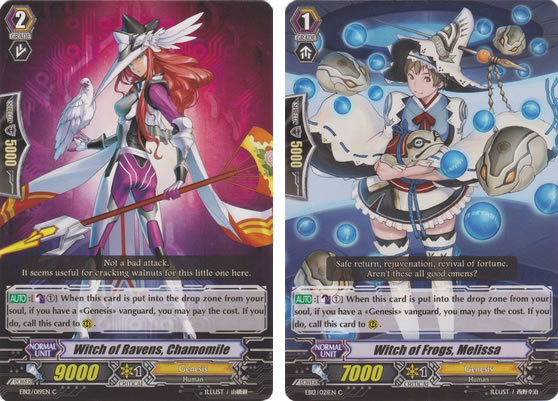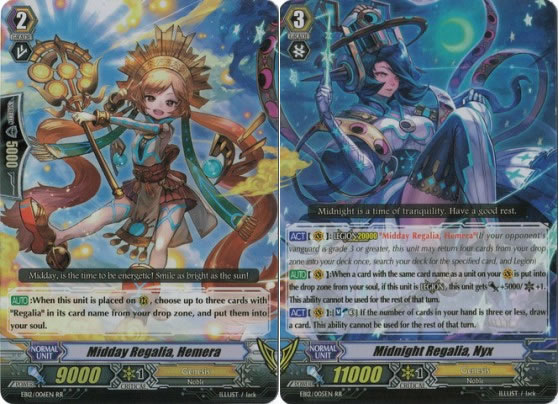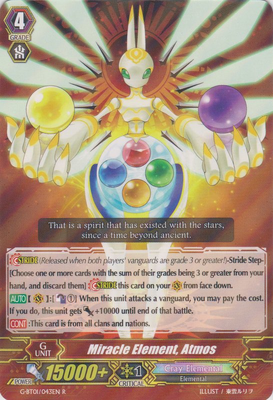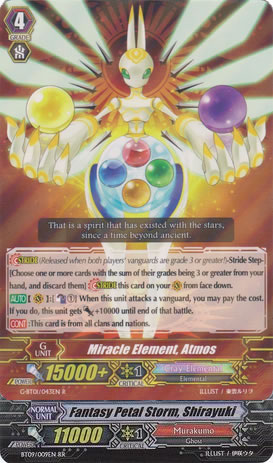How to Play Cardfight!! Vanguard: Effects
Welcome back to our discussion of Vanguard rules! In this instalment, we will be explaining the various effects and their costs, and discussing the more complicated aspects of the game such as timing. This article aims to discuss everything you need to know about how effects in Vanguard interact!
In Vanguard, many actions are shown by a visual shorthand. We have already discussed the Grade abilities of Boost (![]() ), Intercept (
), Intercept (![]() ) and Twin Drive (
) and Twin Drive (![]() ), so we will ignore these and move on to the other symbols!
), so we will ignore these and move on to the other symbols!
Types of abilities
Firstly, there are three main types of abilities:
![]() – Active skills can only be used in the Main Phase of the player’s own turn. When the player wishes to use the ability, they simply pay the cost and then resolve it. Unless they have a ‘once per turn’ clause, these abilities can be used as many times as the player wishes, provided the cost can be paid, and can be used to create serious advantage for the player.
– Active skills can only be used in the Main Phase of the player’s own turn. When the player wishes to use the ability, they simply pay the cost and then resolve it. Unless they have a ‘once per turn’ clause, these abilities can be used as many times as the player wishes, provided the cost can be paid, and can be used to create serious advantage for the player.
![]() – Automatic abilities respond to a specific event, and can only be activated once each time that event occurs. An example might be Battle Sister, Maple, who gains 3000 power when she attacks if her controller has four or more cards in hand. Unless they have a ‘once per turn’ clause, these abilities can be used as many times as their event occurs.
– Automatic abilities respond to a specific event, and can only be activated once each time that event occurs. An example might be Battle Sister, Maple, who gains 3000 power when she attacks if her controller has four or more cards in hand. Unless they have a ‘once per turn’ clause, these abilities can be used as many times as their event occurs.
![]() – Continuous abilities provide lasting benefits for as long as their conditions are fulfilled. For example, this can involve an increase to a units power provided a certain card is in the Soul. Continuous abilities are active on both players’ turns.
– Continuous abilities provide lasting benefits for as long as their conditions are fulfilled. For example, this can involve an increase to a units power provided a certain card is in the Soul. Continuous abilities are active on both players’ turns.
These are often accompanied by a symbol to show where the cards may be activated. This can be ![]() for the Vanguard Circle,
for the Vanguard Circle, ![]() for the Rearguard Circles,
for the Rearguard Circles, ![]() for the Guardian Circle, while other zones are usually put in brackets and followed by a colon, such as ‘[Drop Zone]:’.
for the Guardian Circle, while other zones are usually put in brackets and followed by a colon, such as ‘[Drop Zone]:’.
Costs and effects
Card costs and effects are easily distinguished by the fact that costs are put in brackets following the symbol which designates the zone in which it may be activated. For example, a card could read ‘![]() : [Put this unit into your soul]’, which allows for the card to be read easily and without confusion. The following is a common list of symbols seen as costs and effects.
: [Put this unit into your soul]’, which allows for the card to be read easily and without confusion. The following is a common list of symbols seen as costs and effects.
![]() – One of the most common symbols is Counter Blast. Most often seen as a cost to be paid, a Counter Blast is turning a face-up damage of the player’s choice in their Damage Zone face-down. This limits abilities to being used only after the controller has taken enough damage, and effectively serves as a ‘comeback mechanic’. Abilities with a Counter Blast cost cannot be used unless that many cards can be turned face-down.
– One of the most common symbols is Counter Blast. Most often seen as a cost to be paid, a Counter Blast is turning a face-up damage of the player’s choice in their Damage Zone face-down. This limits abilities to being used only after the controller has taken enough damage, and effectively serves as a ‘comeback mechanic’. Abilities with a Counter Blast cost cannot be used unless that many cards can be turned face-down.
![]() – Counter Charging is the reverse of Counter Blasting. This symbol has only recently begun to be used in the game, and previously has been represented by the phrase ‘choose a card from your Damage Zone, and turn it face up’. This allows the player to re-use cards for Counter Blasts without taking additional damage.
– Counter Charging is the reverse of Counter Blasting. This symbol has only recently begun to be used in the game, and previously has been represented by the phrase ‘choose a card from your Damage Zone, and turn it face up’. This allows the player to re-use cards for Counter Blasts without taking additional damage.
![]() – Soul Blasting is often seen as a cost for abilities, and uses the Soul (the stack of cards under the Vanguard) as its resource. A Soul Blast is to take a card from the Soul and put it in the Drop Zone, and effects using this resource cannot be activated if there are not enough cards in the soul. Without its opposite effect, most players will only have access to two or three Soul over the course of the game.
– Soul Blasting is often seen as a cost for abilities, and uses the Soul (the stack of cards under the Vanguard) as its resource. A Soul Blast is to take a card from the Soul and put it in the Drop Zone, and effects using this resource cannot be activated if there are not enough cards in the soul. Without its opposite effect, most players will only have access to two or three Soul over the course of the game.
![]() – Soul Charging is the reverse of Soul Blasting. This is sometimes seen as a cost, but is more often part of an effect. To Soul Charge, you take x cards from the top of the deck and place them underneath the Vanguard. Trigger effects are not activated at this time.
– Soul Charging is the reverse of Soul Blasting. This is sometimes seen as a cost, but is more often part of an effect. To Soul Charge, you take x cards from the top of the deck and place them underneath the Vanguard. Trigger effects are not activated at this time.
![]() – The Stand symbol shows that you may Stand one of your units, allowing it to attack again.
– The Stand symbol shows that you may Stand one of your units, allowing it to attack again.
![]() – Often seen as a cost, the Rest symbol tells you to Rest one of your units. As always, Rested units cannot attack unless they are made to Stand by an effect.
– Often seen as a cost, the Rest symbol tells you to Rest one of your units. As always, Rested units cannot attack unless they are made to Stand by an effect.
Swords and Shields represent power and shield value, respectively.
Special restrictions
Certain abilities are restricted to only being used at a certain point in the game, and they have special symbols which represent them:
![]() /
/![]() – Limit Breaks are somewhat of an older mechanic, but one which is still seen in many decks today. Limit Break abilities are always restricted to the
– Limit Breaks are somewhat of an older mechanic, but one which is still seen in many decks today. Limit Break abilities are always restricted to the ![]() , and restrict the ability they govern to only being used after a certain amount of damage has been taken. This is usually four damage (
, and restrict the ability they govern to only being used after a certain amount of damage has been taken. This is usually four damage (![]() ), but can be five damage (
), but can be five damage (![]() ). As these abilities can essentially only be used on the verge of defeat, they are usually stronger than similar skills. Many Clans now have support cards which allow Limit Break abilities to be used on three or less damage, allowing players to use these powerful abilities before taking significant damage.
). As these abilities can essentially only be used on the verge of defeat, they are usually stronger than similar skills. Many Clans now have support cards which allow Limit Break abilities to be used on three or less damage, allowing players to use these powerful abilities before taking significant damage.
![]() – Legion is an interesting mechanic which, in short, allows there to be two units on the Vanguard Circle. Before I explain how Legion works, I will briefly explain how it governs other units. Certain abilities can only be used when your Vanguard is in Legion, and they have two different timings. One is ‘if your Vanguard is
– Legion is an interesting mechanic which, in short, allows there to be two units on the Vanguard Circle. Before I explain how Legion works, I will briefly explain how it governs other units. Certain abilities can only be used when your Vanguard is in Legion, and they have two different timings. One is ‘if your Vanguard is ![]() ‘, which means that the ability can be used at any point after Legion has been performed; the other is ‘when your Vanguard
‘, which means that the ability can be used at any point after Legion has been performed; the other is ‘when your Vanguard ![]() ‘, which means that it can only be used immediately after Legion has been performed, just like how Automatic abilities work. To skip to how to perform Legion, click here.
‘, which means that it can only be used immediately after Legion has been performed, just like how Automatic abilities work. To skip to how to perform Legion, click here.
![]() /
/![]() – Generation Break is a mechanic seen only on cards from the G-Boosters. This restricts abilities to only being used when there are face-up G-Units on the Vanguard Circle or in the G-Zone. The G-Zone is a separate deck of up to eight cards, and contains Grade 4 units which cannot be included in the main deck – they are turned face up by performing an action called Stride, which is only available when both players have upgraded their Vanguard to Grade 3 or higher. To skip to how to perform Stride, click here.
– Generation Break is a mechanic seen only on cards from the G-Boosters. This restricts abilities to only being used when there are face-up G-Units on the Vanguard Circle or in the G-Zone. The G-Zone is a separate deck of up to eight cards, and contains Grade 4 units which cannot be included in the main deck – they are turned face up by performing an action called Stride, which is only available when both players have upgraded their Vanguard to Grade 3 or higher. To skip to how to perform Stride, click here.
Simultaneous abilities
Sometimes, several cards will have the timing for their effects fulfilled at the same time. In this case, the player decides the order in which the effects will activate.
For example, if Witch of Ravens, Chamomile and Witch of Frogs, Melissa were Soul Blasted at the same time, both of their effects would be able to activate at once. However, they are resolved one at a time, so the player would call one of the cards, then call the other. Either Melissa or Chamomile can be called first, and both will be able to be called.
In Vanguard, effects cannot ‘miss the timing’ – when an automatic ability has been triggered, it is always able to resolve if applicable. This means that, even if abilities interrupt others, they can still activate. Let’s look at a more complicated example:
In this example, the two copies of Onifundo activate at the beginning of the Main Phase. The player decides to use the first copy of Onifundo to call Hiden Scroll. At this point, the player can resolve Hiden Scroll or the second Onifundo, but chooses to resolve Hiden Scroll. Hiden Scroll returns to the deck to call two copies of Million Rat, both of whose effects could activate at this time. At this point, the player can choose to activate either the effects of Million Rat or of the second Onifundo. The player chooses to Counterblast 1 to call another Million Rat, then finally resolves the second Onifundo. Even though both Onifundo activated at the same time, one was resolved much later than the other!
It is also worth noting that players may choose the order in which effects end in the End Phase. If a unit is locked, for example, but is also supposed to return to the deck in the End Phase, the player may choose to return it to the deck first (which it cannot do, owing to how Lock works), then unlock it. This also works with Stride – players can return the Stride unit to the G Zone before or after resolving other End Phase effects.
Legion is an active ability which may only be used by certain Vanguards when both players have a Grade 3 or greater Vanguard. It allows the Vanguard to share the Vanguard Circle with another specific unit, counting as one Vanguard. Usually, this is between a Grade 3 and a Grade 2, but sometimes it is two Grade 3s. Don’t worry, this is less confusing than it sounds! The easiest way to understand Legion is to look at an example:
This is a unit in Legion state. To Legion, you use the active ability of your Vanguard to return exactly four cards from the Drop Zone to the Deck, search the deck for the ‘Mate’ (which, in this case, is Midday Regalia, Hemera’) and place it alongside the Vanguard. As you can see, not only does the art flow over between the cards, but there are additional symbols on the bottom of the cards, forming a crest. This serves as a reminder that the Mate is placed to the left of the ‘Leader’. At this point, both units are the player’s Vanguard, and take up only the Vanguard Circle.
When a Vanguard in Legion attacks, it counts as having the combined power of the two units, shown by the ‘Legion 20000’ on the Leader. The Vanguard can be boosted as usual, and may perform two Drive Checks, as per its Twin Drive ability. If an attack in Legion hits, then, unless an effect states otherwise, it does one damage, just like a normal Vanguard. When a unit in Legion is attacked, however, only the Leader’s power is used to calculate who wins. For the purposes of defence, therefore, the above pair would only be at 11000 power, and so Legion can be seen as a more offensively focussed skill.
Legion may be performed in the Main Phase of any turn, provided the card has not already performed Legion. If the player using Legion went first, when they rode to Grade 3, they would not be able to perform Legion on that turn (as their opponent would be on Grade 2) – on their next turn, however, it would be possible for Legion to occur! Legion may only be performed once with the same Vanguard, so, if a player wishes to perform Legion again, then they must first Ride another Vanguard. When a Vanguard in Legion is ridden over in this way, both the Mate and the Leader enter the soul.
Striding is perhaps an easier mechanic to understand than Legion. Players may have a separate deck of eight face down Grade 4 units, which is placed in the G-Zone. When both players have a Vanguard of Grade 3 or higher, a player can discard cards from their hand with a total grade of 3 or higher to choose one face-down unit and place it on top of their Vanguard. This occurs in the Stride Phase, which follows the Ride Phase, allowing the player who goes second to Stride first. This is an example G-Unit:
There are two things to note about the card: it has ![]() (Triple Drive), which allows it to check three cards from the top of the deck when it attacks; secondly, its power is 15000+. Stride units are unique in the fact that they take on the characteristics of the card they Strode on top of. The previous Vanguard (or Vanguards, if in Legion) become the Heart, and you choose one of the Heart Units, and the Stride unit gains that card’s name, power and state (as in being at Rest or Stand).
(Triple Drive), which allows it to check three cards from the top of the deck when it attacks; secondly, its power is 15000+. Stride units are unique in the fact that they take on the characteristics of the card they Strode on top of. The previous Vanguard (or Vanguards, if in Legion) become the Heart, and you choose one of the Heart Units, and the Stride unit gains that card’s name, power and state (as in being at Rest or Stand).
In this example, ‘Miracle Element, Atmos’ is also called ‘Fantasy Petal Storm, Shirayuki’, and has 26000 power when it attacks. This only uses the printed power of the card. The Normal Unit Shirayuki is not considered to be in the Soul, as the Heart is different.
Strides only last until the end of the turn they were used. At the End Phase, the G-Unit returns to the G-Zone face-up, and that face-up card cannot be used again. The Vanguard remains in the state the Stride was in at the end of the turn (so, it would be at rest if the G-Unit attacked), and the Heart Cards become the Vanguard again. Any cards in Legion remain in Legion state though are not counted as Legion when you have a G-Unit on the Vanguard Circle, so effects that only work if your Vanguard is in Legion wont take effect.
Summary
In this instalment, we have covered effect types, symbols, timings, Legion and Striding. In the next instalment, we will cover G-Assist and the rules for deck construction!
Cardfight Vanguard singles are available to purchase at Big Orbit Cards: Cardfight Vanguard.






Pingback:How to Play Cardfight!! Vanguard: The Absolute Basics | Big Orbit Games
Pingback:How to Play Cardfight!! Vanguard: Deck Construction | Big Orbit Games